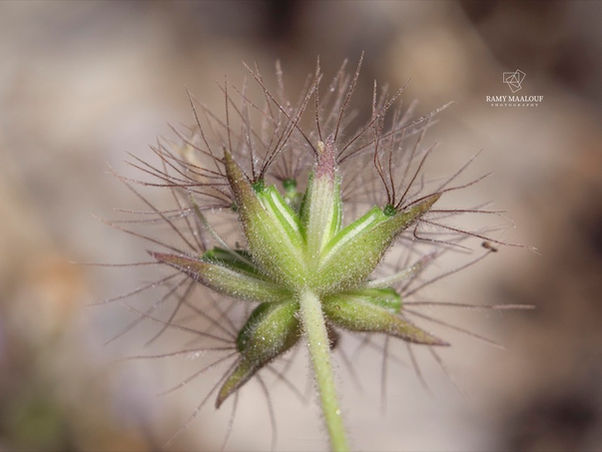Family |
Caprifoliaceae
Pterocephalus plumosus
(L.) Coult.
Pterocephalus plumosus (L.) F. Dietr.
(Nachtr. Vollst. Lex. Gärtn. 7: 5; 1821 – Nouvelle Flore du Liban et de la Syrie, vol. 2, Pl. CCXXVIII nº 3; 1969)
• Life-form & habit: Perennial herb forming loose tufts, 20–60 cm tall, with a woody rootstock and slender, erect to ascending stems. Stems branched above, whitish or grey-green, covered with short, appressed hairs.
• Leaves: Basal leaves forming a rosette, pinnatifid to pinnatisect, 5–15 × 1–3 cm, with narrow, linear to lanceolate lobes, margins entire or slightly undulate. Cauline leaves smaller, less divided, sessile, and decurrent along the stem. Both surfaces greyish-tomentose.
• Inflorescence & flowers: Capitula solitary or few, terminal, 2–3 cm in diameter. Involucre campanulate with numerous narrow, imbricate bracts; outer bracts linear-lanceolate, often tinged purplish. Corolla pink to lilac, zygomorphic, 5-lobed, outer florets larger and radiant. Calyx with long plumose, feathery bristles — a distinctive feature of the species.
• Fruit: Achene cylindrical to oblong, crowned by the persistent feathery calyx forming a plume-like structure aiding wind dispersal.
• Phenology: Flowers from May to August; fruits mature from June to September.
• Habitat & elevation: Dry rocky slopes, open grasslands, and steppe-like areas on limestone or marl, 400–1 800 m. Prefers sunny, well-drained sites.
• Lebanese distribution: Reported by Mouterde from Mount Lebanon and Anti-Lebanon — notably Dahr el-Baïdar, Barouk, Falougha, Zahlé, and Ras Baalbeck; also found on the foothills of Jabal Sannine and the Hermon range.
• Native range: Albania, Bulgaria, East Aegean Islands, Egypt, Greece, Iran, Iraq, Kriti, Krym, Lebanon–Syria, North Caucasus, NW. Balkan Peninsula, Palestine, Sinai, Transcaucasus, Turkmenistan, Türkiye, Türkiye-in-Europe (POWO).
• ⚠️ Taxonomic note: A widespread Mediterranean–Irano-Turanian species characterised by its feathery calyx and radiate pinkish heads. Sometimes divided into regional forms (subsp. plumosus, subsp. syriacus) based on calyx length and hair density. Easily distinguished from Pterocephalus pulverulentus by its longer, plumose bristles and less densely tomentose leaves.







